In 1938, science fiction author John W. Campbell intricately weaved together science fiction and horror with his short story “Who Goes There,” a tale far ahead of it’s time. Set in a remote outpost in the Arctic, the story revolves around the discovery by the outpost occupants-a group of scientists-who uncover the body of a frozen alien who, when thawed, comes to life and begins attacking the station inhabitants, capable of imitating any life form it engulfs.
Director Howard Hawkes took the story and gave audiences his interpretation of it in a 1951 movie titled THE THING, which starred James Arness as a Frankenstein-esque monster doing battle with the Arctic scientists. The movie, although falling far short of the monster conceived in Campbell’s original work, was an inspiration of terror to many of its viewers, including a young John Carpenter.
Many years later, Carpenter, having read Campbell’s short story, and already garnering a reputation for himself as a director for movies like HALLOWEEN, THE FOG, and ESCAPE FROM NEW YORK, wanted to remake THE THING, and do it in a way that was truer to the original story. After failed attempts by other writers to conceive a remake by other filmmakers such as Tobe Hooper, Carpenter was given the green light.
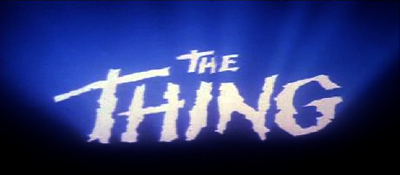
THE CAST
Kurt Russell . . . . . . . R.J. MacReady
Wilford Brimley . . . . . . . . . Dr. Blair
T.K. Carter . . . . . . . . . . . . . . . . . Nauls
David Clennon . . . . . . . . . . . Palmer
Keith David . . . . . . . . . . . . . . Childs
Richard A. Dysart . . . . . Dr. Copper
Charles Hallahan . . . . . Vance Norris
Peter Maloney . . . George Bennings
Richard Masur . . . . . . . . . . . . . Clark
Donald Moffat . . . . . . . . . . . . Garry
Joel Polis . . . . . . . . . . . . . . . . . Fuchs
Thomas G. Waites . . . . . . . Windows
Norbert Weisser . . . . . . Norwegian
Larry J. Franco . Norwegian w/rifle
Nate Irwin . . . . . . . Helicopter pilot
THE PLOT
This time set in the Antarctic, the movie begins with a Norwegian pair in a helicopter chasing a large Siberian husky across the snow. The pursuit takes them to a U.S. base, where the surprised American scientists are forced to take action against the seemingly mad gun-wielding Norwegian, sparing the dog.
Learning more about the Norwegians and their camp nearby, medical doctor Copper (played by Richard Dysart) and helicopter pilot MacReady (played by Kurt Russell) fly to the now desolate and ramshackle camp, where they find little more than destruction, debris, and burned bodies. But in a back room, MacReady discovers a large block of ice, out of which something was thawed. But whatever it was isn’t there now.
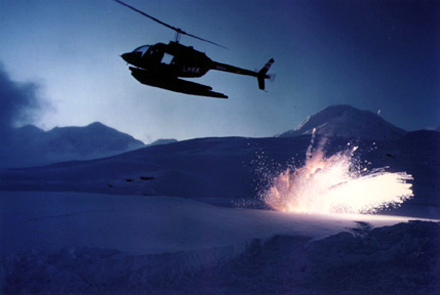
After returning to the camp, Copper and biologist Blair (played by A. Wilford Brimley) examine the charred remains of what appears to be the burned body of a Norwegian, which although generally appears to be normal, doesn’t look exactly right.
Later that night, the husky which had entered the camp is placed by dog handler Clark (played by Richard Massur) into the dog kennel with the other dogs. The dog, after being left alone in the kennel, turns out not to be a dog at all, but rather something far more terrible. The loud chaotic struggle attracts the attention of the men, and a brief but terrible battle ensues, ending – so we think – with the creature being burned by the flamethrower of Childs (played by Keith David).
An in-depth examination of the creature by Blair, Copper, and assistant biologist Fuchs (played by Joe Polis) reveals that the creature was in the process of assimilating three of the kennel dogs, processing duplicates of the animals as it consumed them, each animal becoming another deadly creature.
From then on, nothing is the same, and distrust begins to run high. It is discovered that the dog had been left unchecked the entire day, free to roam about, and evidence points to the disturbing possibility that the imitation dog successfully assimilated at least one or more of the men. Gradually, paranoia begins to grow, and Blair snaps, effectively cutting off the rest of the camp from any chance of reaching or contacting civilization. Blair is eventually subdued by the others, and isolated.
After the men discuss options, Copper proposes a blood serum test for detection of imitations, but before he can successfully implement it, one of the imitations accesses and sabotages the stored blood in the lab. Immediate suspicion points to Copper and base leader Garry (played by Donald Moffet), the only two with known access to the blood storage. An argument breaks out among the men, eventually prompting Garry to hand over leadership of the camp to MacReady. The blood is then destroyed.
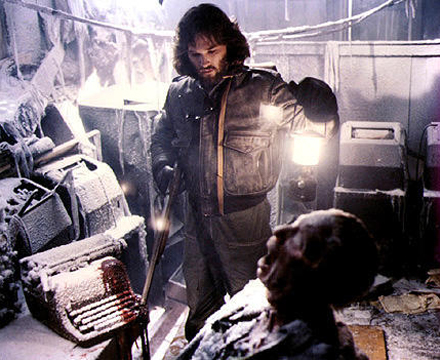
Macready sequesters Garry, Copper, and Clark from the others, being highly suspect of them, and instructs Fuchs to work on another possible test. During this time, the camp power goes out for an hour, and Fuchs is later found dead outside of the camp. While finishing their search, Nauls, the camp cook (played by T.K. Carter) spots a tattered set of clothing, labeled with MacReady’s name on it. Panicking, he runs back inside, leaving MacReady to freeze in the cold Antarctic ice.
Returning to the camp, MacReady makes his way to the storage room window, and breaks in. Armed with dynamite, and filled with both fatigue and anger, MacReady demands that nobody gets out of his sight from now on. Another scuffle ensues, during which one of the men suffers a heart attack. Copper is brought in to attempt to revive the downed man, and it is during this time that the Thing makes another terrible appearance. Quickly, MacReady lets loose upon it with a stream of fire, and kills it.
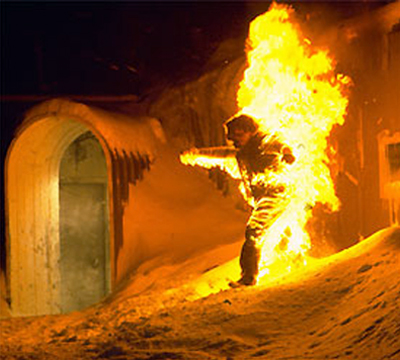
The second encounter gives MacReady an idea, which he quickly acts upon. The men discover that “every part of the creature is a whole.” MacReady theorizes that a blood specimen taken from one of the imitations will form a completely new creature and try to survive when attacked. He takes samples from everybody, and one by one tests the samples by dipping a red hot wire in each sample dish. Another imitation is discovered-this one killing another crew member before being blown up with a stick of dynamite.
Having successfully tested the others, the men move out toward the tool shed to test the isolated Blair. But upon entering, they find that Blair is gone, and in his place are the beginnings of an aerial craft of some sort under construction, made from pieces of the destroyed helicopters. Promptly destroying the incomplete ship, the men move out to find Blair, who is more than likely now an imitation.
Suddenly, the camp generator goes out-later it is discovered to have been removed from the generator room. The men, realizing that the Thing is attempting to re-freeze itself into the ice in order to be found by a rescue team, begin to burn down the compound, giving the creature no place to hide, and working their way down to the generator storage room, where the final battle ensues with the Thing.
THE CREW
Brought aboard to assist Carpenter with the movie was special effects specialist Rob Bottin, who already had the films THE FOG and THE HOWLING under his belt. Bottin replaced specialist Dale Kuipers, relieved due to a motor vehicle accident, whose original concept of the monster was actually closer to the creature from ALIEN than Campbell’s shape shifter. In contrast, Bottin stepped up with radical ideas, scrapping Kuiper’s models and bringing back the original concept of the creature as intended by Campbell – a thing that assumes the form of whatever it eats.
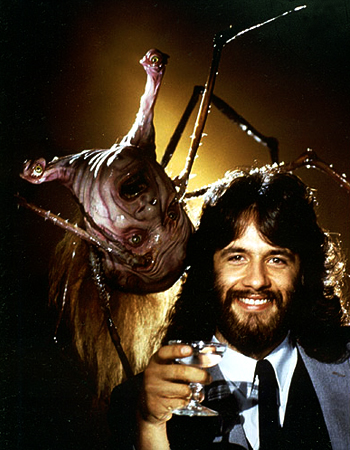
The special effects stand out on this movie, head and shoulders above anything else of the day. Over twenty years later, they hold up incredibly well, and are more than a match for many of the CGI-based effects that permeate the silver screen. Bottin (along with Stan Winston, who assisted Rob in the movie’s dog-kennel scene) masterfully works with prosthetics, puppetry, and makeup to create perhaps one of the most bizarre and hideous monsters that has ever appeared onscreen.
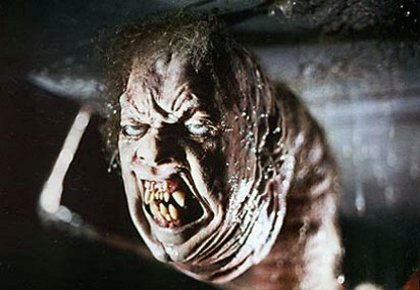 | 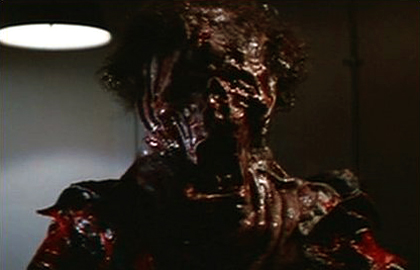 |
Helping out to write the screenplay was Bill Lancaster, son of actor Burt Lancaster, who was not so much interested in the science fiction aspect of the film as he was in the notion of isolationism and paranoia. Lancaster masterfully painted a picture of a group of men who go from a tight bond and camaraderie at the beginning to a distrust and even outright hostility toward one another as the movie unfolds. His characterizations are well done, and combined with Carpenter’s directing make for a solid feeling of wonder regarding who can and cannot be trusted.
Rounding out the crew who helped to make this film work behind the scenes are Albert Whitlock (matte paining artist who also worked on THE BIRDS), Dean Cundey (director of photography who worked with Carpenter on THE FOG) and Ennio Morricone (music composer).
REVIEW
THE THING should be required watching for anybody who enjoys a good blend of science fiction and horror. The special effects, the acting, the plot, and the action all weaved into suspenseful atmosphere of isolation and paranoia make for a great movie. The cast pull off their roles sincerely, without any sense of tongue-in-cheek performing, and each character stands well alone as well as with the group. Bottin’s special effects greatly enhance the movie without dominating it to the point of being a gore-fest. Carpenter does a good job adapting Lancaster’s screenplay to the celluloid, making some changes along the way, but overall sticking to the intended format (for those who would prefer to see a treatment that retains more of the original screenplay, Alan Dean Foster wrote the movie novel based upon Lancaster’s original draft). From beginning to end, the movie keeps the viewer’s attention, with little superfluous material and no distraction from the core of the film. A must-watch classic.
-Written by Tribe 13